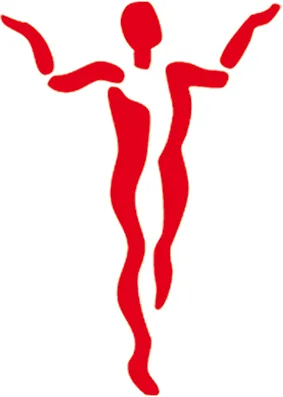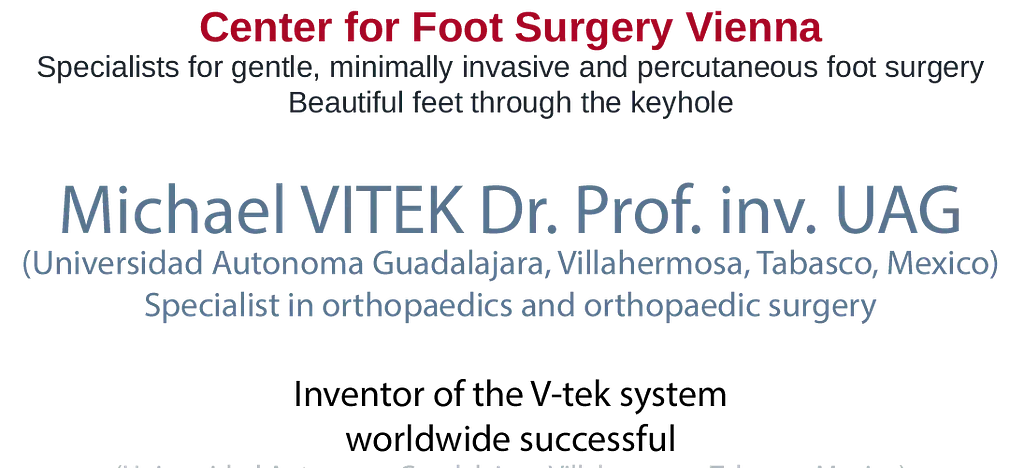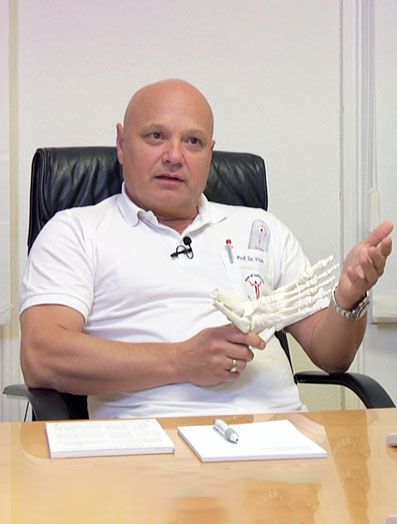Your specialist for minimally invasive hallux valgus and foot surgery.
We do not have any contracts with public insurances. Wahlarztordination.
- NEWS: We operate calcaneus altus (Haglund exostosis) and heel spur minimally invasive.
- An international workshop in Lisbon about "Hallux Surgery (R)Evolution - Open vs. Mini Invasive" was headed by Dr. Michael Vitek.
- Dr. Michael Vitek spoke in Austrian TV about Hallux valgus. Here is the link.
- Michael Viteks book "Gesunder Fuß, schmerzfrei ohne Narben" about the minimally invasive foot surgery is available at Amazon and Heelverlag. Price: € 14,99. Please find the other books from Dr. Michael Vitek „about Dr. Michael Vitek/ books“.
- Dr. Vitek's ideas and implants are copied and replicated many times
Foot complaints
The foot is an extremely complicated part of our body. Some even call it an "organ". If they function well and properly, we actually do not even notice our feet.
However, the slightest problem should be avoided. We all know how unpleasant a little stone in a shoe is, or how terribly oppressive or too small shoes are. You want to do everything you can to free your feet. Each of us knows that "harmless" foot problems such as corns, blisters caused by bad shoes or even nail suppurations can bother us much more than problems elsewhere.
Of course, even bigger foot problems cause us all the more complaints.
Why the feet are so dominant in diseases is explained by their exposed position and the small size of their "components": The delicate bones with the strong tendons have to withstand many times our body weight when accelerating walking or jumping and all structures are "crammed together" in a very small space, so that a problem often involves the neighbouring parts as well. The often underestimated biomechanics play an enormous role in the absorption of force (absorption of kinetic energy) and in rolling processes during walking.
During the developmental shaping of the foot, a compromise was made between small size and robustness for optimal function.
Treatment of foot complaints
Treating or even operating on the feet belongs first and foremost in the hands of an experienced specialist in orthopaedics and orthopaedic surgery. The support of orthopaedic technicians and master orthopaedic shoemakers is often necessary.
The practice often practised in large hospital departments of leaving simple forefoot operations to the youngest assistants unfortunately often takes its revenge, because there are no "simple" operations and any foot problem that is not adequately treated can have major consequences. For example, after unsuccessful hammer toe operations, malpositioning of the big toe can occur in the first place (hallux valgus), heel and metatarsal problems up to and including knee, hip and spine problems can occur.
International specialisation in the foot
In recent decades, the practice of specialising in the foot (there are even separate Foot and Ankle Universities that train specialists for foot medicine and foot surgery!), which has long been practised in the USA, has also been introduced in Europe, albeit to a much lesser extent. Foot societies and foot centres have emerged, which deal with the specialised treatment of foot problems.
These specialists also train interested doctors in foot medicine.
My specialization
Following my own interests, I have been dealing with the diseases and treatments of the foot (besides the knee) for over 40 years.
In addition to scientific publications and after more than 3000 foot operations, this has resulted in the popular scientific book "Hilfe bei Fußschmerzen" (Help with Foot Pain), which was published in 2006 as a patient guide by Kneipp Publishers.
As I was not always very happy with the methods (described in great numbers in the scientific literature) for the treatment of forefoot problems such as hallux valgus, hammer toes and splayfoot problems, I began to develop technique modifications and my own new surgical techniques in 2003. Implants that were developed according to my ideas are now patented or registered trademarks (V-tek®) worldwide.
Since these techniques are now, after about 10.000 operations, very mature and can be offered to a broad public, I established an outpatient centre for foot surgery in my practice in Vienna-Meidling in October 2007. These new operations allow immediate loading of the operated foot without protruding wires.
For most patients, there is little swelling and little pain after the operation - also thanks to the new operations through the keyhole - so it is possible to offer these operations on an outpatient basis, i.e. without the need for an inpatient stay in hospital.
International interest and further education by Dr. Vitek
The medical interest in my surgical methods is very high. In 2007 alone, I was in England (London, Cambridge and Grantham), Spain (Salamanca), Russia (head of the master class for foot surgery in Tomsk) and Germany (Munich and Tuttlingen) several times to explain and teach my methods at congresses, seminars and workshops.
In spring 2008 I held the 1st V-tek Foot Surgery Course for Foot Surgeons at the Sigmund Freud Private University in Vienna, followed by further courses at the Institute of Anatomy at the Medical University of Vienna. In autumn 2008 I gave lectures and an extensive workshop (possibility for foot surgeons to practice the methods on the cadaver) at the College of Podiatric Medicine in Cleveland, Ohio, USA, a university specialising exclusively in feet.
Further workshops and lectures took place in December 2008 in Munich at the German Foot Surgeons Congress of the GFFC and in March 2009 in Going at the international conference of the Austrian Society of Foot Surgery. Several publications of these methods have appeared in international journals.
Further invitations for lectures and foreign operations took me to many other European countries, the USA, Mexico, Argentina and Indonesia in the following years. This was followed by professorships in Malta (at an unrecognised further education university) and in Mexico (at the very large, state-recognised Universidad Autonoma de Guadalajara, whose diplomas are recognised in the USA even without nostrification).
Lectures for specialists combined with surgical instructions on patients or on cadaveric feet, e-mail consultation of operating specialists based on x-rays and medical histories, as well as lectures and full-day seminars for patients have been part of our normal daily routine for years now.
Nevertheless, the development is never finished and the operations are constantly being improved based on the rich daily experience. Recently, we have been operating on almost all toe corrections, i.e. hallux valgus, hammer toes, tailor's bunion and splayfoot problems in a minimally invasive way, i.e. with the smallest possible incisions, which are actually just stitches or a few millimetres in size.
This is usually possible during initial operations, and must be considered and considered on a case-by-case basis for corrections after failed previous operations (which are assigned to us in increasing numbers) due to internal scarring.
Foot problems
The foot is a very complex part of our body. Sometimes it is even referred to as an "organ". If they work well and properly, we actually do not even notice our feet.
But woe if only the smallest problems occur. We all know how unpleasant a pebble in the shoe, or how horrible pinching or too small shoes can be. You want to do everything possible to free the feet. Each of us knows that "harmless" foot ailments such as corns, blisters caused by bad footwear or even nailbed pus can plague us a lot more than problems elsewhere.
A fortiori, major foot problems cause us all the more complaints of course.
Why the feet are so dominant in case of diseases is due to their exposed location and the small size of their "constituents". The delicate bones with the strong tendons need to withstand many times our body weight in case of acceleration of running or jumping and all the structures are "crammed" in a confined space, so that a problem often pulls in the neighboring units to the disease. The often underestimated biomechanics plays an enormous role in force absorption (absorption of the kinetic energy) and scrolling operations while walking.
In the evolutionary shaping of the foot, a compromise between the small size and robustness was made for optimum performance.
Treatment of foot complaints
To treat or operate the foot at all, is primarily in the hands of an experienced specialist in orthopedics and orthopedic surgery. Often the support of orthotists and orthopedic shoemakers is necessary.
The common practice in large hospital wards, i.e. to let the younger assistants do the easier forefoot surgeries, unfortunately often backfires because there are no "easy" operations and each foot problem not adequately treated can cause major consequences. For example, deformities of the hallux may occur due to unsuccessful hammertoe surgeries, or heel and midfoot problems and even knee, hip and spine ailment.
International specialization - foot on the subject
In recent decades, the long practiced U.S. specialization in the topic of the foot (there's even own foot universities that train specialists for foot medicine and foot surgery!) was introduced in Europe, albeit to a much lesser extent. There emerged foot organizations and foot centers that deal with the specialized treatment of foot problems that were not valued enough in large general-orthopedic departments as would be necessary.
These specialists provide continued training to interested doctors in foot medicine.
My specialty
Following my own interests, I have now worked for over 20 years on the disease and treatment of the foot (in addition to the knee).
In addition to scientific publications and after more than 3.000 foot surgeries, I wrote the popular science book "help with foot pain" , which was published in 2006 by the Kneipp Verlag as a patient counselor.
Since I was not always very happy with the methods for treatment of the forefoot problems (very numerously described in the scientific literature) like hallux valgus, hammer toes, splay, I started to develop technical modifications and own new surgical techniques in 2003.
Since these techniques have been perfected after around 10.000 operations and can be widely offered, I inaugurated an outpatient center for foot surgery in my practice in Vienna Meidling, the "House of hallux" in October 2007. These new operations allow an immediate loading of the operated foot without protruding wires.
Most patients only have a little swelling and only slight pain occurs after surgery, so outpatient operations, without the need for an inpatient stay in the hospital are possible to offer.
International interest and seminars by Dr. Vitek, Prof. inv. UAG
The medical interest in my methods of operation is very large. Alone in 2007, I was several times in England (London, Cambridge and Grantham), Spain (Salamanca), Russia (head of the master class for Foot Surgery in Tomsk) and Germany (Munich, Tuttlingen, Germany), to explain my methods in the context of conferences, seminars and workshops and to teach.
In the spring of 2008, I held the first V-tek Foot Surgery Course for foot surgeons at the Sigmund Freud University in Vienna, which was followed by further courses in the Anatomical Institute of the Medical University of Vienna. In the fall of 2008, I gave lectures in Cleveland / Ohio / USA and held an extensive workshop (possibility for foot surgeons to practise the methods on a corpse).
Other workshops and lectures were in December 2008 in Munich and in March 2009 in Going at the Int. Meeting held by the Austrian Society for Foot Surgery. Several publications of these methods have appeared in international journals and more have been filed. Other invitations to lecture and operate abroad led me to many other European countries, USA, Canada, Mexico, Argentina, Russia, Turkey and Indonesia in the following years. Professorships in Malta and Mexico followed. Ongoing seminars and lectures are now part of my professional life.
Our development has been proven since 2005 internationally x-fold
- Foot surgery without drill wires - so no entry points for germs, no sacrificing of comfort, immediate movement of the joints for faster recovery, instead of cartilage loss and adhesions due to fixation by wires.
- Anatomic correction of hammer toe instead of bone removal - no wobbly stub toes, no loss of toe length, good kick in walking and running instead of the usual quasi amputation by the Hohmann technique.
- Reliable, safe Hallux correction - with the smallest cuts.
- Anatomic correction of hallux without loss of length - even in case of massive or even bizarre deformities, no transfer of the ground forces to the small metatarsal heads with subsequent pain.
- Possible now thanks to new implants and operation methods - the operating technique depends on the degree of deviation. There are 3 different surgical techniques for the hallux and 5 different techniques for the hammer toe - depending on the severity and stage. The implants are made of titanium and are (usually) not removed. Individual approach to the patient and to each foot, instead of "lumping it together" with a single surgical technique.
- Full load immediately possible for all operations - even at maximum corrections.
- Minimally invasive surgery for less pain, less swelling and a fast recovery.
Dr. Michael Vitek Prof. in. UAG
(Universidad Autonoma Guadalajara, Villahermosa, Tabasco, Mexico)



